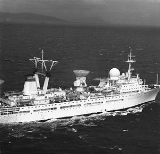
Akademik Sergei Korolev
Encyclopedia
The Akademik Sergei Korolev was a space control-monitoring ship constructed in 1970 to support the Soviet space program
. Named for Sergei Korolev, the head Soviet rocket engineer and designer during the Space Race
between the United States
and the Soviet Union
in the 1950s
and 1960s
, the ship also conducted upper atmosphere
and outer space
research.
In Soviet times, the Akademik Sergei Korolev was a large communications ship which was part of a fleet of communications ships. These ships greatly extended the tracking range when the orbits of cosmonauts and unmanned missions were not within range of Soviet land-based tracking stations
. The ship mainly operated in the Atlantic Ocean
monitoring spacecraft trajectory, telemetry data, and guaranteed a communications link with the cosmonauts.
The ship had about 1200 accommodations, including 79 laboratories, in which 188 scientific workers performed their duties.
In 1975, the ship was a part of the Soviet-American Apollo-Soyuz joint test program.
Soviet space program
The Soviet space program is the rocketry and space exploration programs conducted by the former Union of Soviet Socialist Republics from the 1930s until its dissolution in 1991...
. Named for Sergei Korolev, the head Soviet rocket engineer and designer during the Space Race
Space Race
The Space Race was a mid-to-late 20th century competition between the Soviet Union and the United States for supremacy in space exploration. Between 1957 and 1975, Cold War rivalry between the two nations focused on attaining firsts in space exploration, which were seen as necessary for national...
between the United States
United States
The United States of America is a federal constitutional republic comprising fifty states and a federal district...
and the Soviet Union
Soviet Union
The Soviet Union , officially the Union of Soviet Socialist Republics , was a constitutionally socialist state that existed in Eurasia between 1922 and 1991....
in the 1950s
1950s
The 1950s or The Fifties was the decade that began on January 1, 1950 and ended on December 31, 1959. The decade was the sixth decade of the 20th century...
and 1960s
1960s
The 1960s was the decade that started on January 1, 1960, and ended on December 31, 1969. It was the seventh decade of the 20th century.The 1960s term also refers to an era more often called The Sixties, denoting the complex of inter-related cultural and political trends across the globe...
, the ship also conducted upper atmosphere
Aeronomy
Aeronomy is the science of the upper region of the atmosphere, where dissociation and ionization are important. The term aeronomy was introduced by Sydney Chapman, and the above definition stems from 1960. Today the term also includes the science of the corresponding regions of the atmospheres of...
and outer space
Outer space
Outer space is the void that exists between celestial bodies, including the Earth. It is not completely empty, but consists of a hard vacuum containing a low density of particles: predominantly a plasma of hydrogen and helium, as well as electromagnetic radiation, magnetic fields, and neutrinos....
research.
In Soviet times, the Akademik Sergei Korolev was a large communications ship which was part of a fleet of communications ships. These ships greatly extended the tracking range when the orbits of cosmonauts and unmanned missions were not within range of Soviet land-based tracking stations
Earth station
A ground station, earth station, or earth terminal is a terrestrial terminal station designed for extraplanetary telecommunication with spacecraft, and/or reception of radio waves from an astronomical radio source. Ground stations are located either on the surface of the Earth, or within Earth's...
. The ship mainly operated in the Atlantic Ocean
Atlantic Ocean
The Atlantic Ocean is the second-largest of the world's oceanic divisions. With a total area of about , it covers approximately 20% of the Earth's surface and about 26% of its water surface area...
monitoring spacecraft trajectory, telemetry data, and guaranteed a communications link with the cosmonauts.
The ship had about 1200 accommodations, including 79 laboratories, in which 188 scientific workers performed their duties.
In 1975, the ship was a part of the Soviet-American Apollo-Soyuz joint test program.
External links
- A. Karpenko, ABM and Space Defense, Nevsky Bastion, No. 4, 1999, pp. 2-47, Federation of American Scientists (Online)

